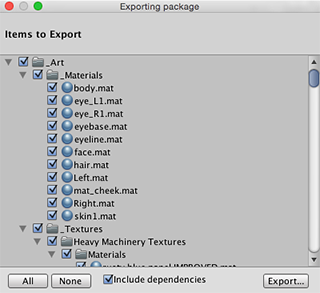Asset Packages
Unity are a handy way of sharing and re-using Unity projects and collections of assets;
Unity and items on the Unity are supplied in packages, for example.
are collections of files and data from Unity projects, or elements of projects,
which are compressed and stored in one file, similar to Zip files.
Like Zip files, a package maintains its original directory structure when it is unpacked,
as well as meta-data about assets (such as import settings and links to other assets).
In Unity, the menu option compresses and stores the collection, while unpacks the collection into your currently open Unity project.
NOTE: Importing changed or upgraded packages gives you a option.
Note that if you choose this option, Unity first deletes the existing assets associated with the package before installing a new version.
If you think you may need the older version, back it up before re-installing by making a copy of the files.
For further information on re-installing, see Upgrading Packages.
This page contains information on:
- Import Package: - Standard Asset Packages - Custom Packages
- Export Package
- Exporting Updated Packages
Import Package
You can import , which are asset collections pre-made and supplied with Unity, and , which are made by people using Unity.
Choose to import both types of package.

Standard Asset Packages
Unity consist of several different packages: .
To import a new package:
Open the project you want to import assets into.
Choose plus the name of the package you want to import, and the dialog box displays, with all the items in the package pre-checked, ready to install. (See Fig 2: New install Import Unity Package Dialog Box.)
Select and Unity puts the contents of the package into a folder, which you can access from your .

NOTE: Updating Standard Asset Packages - When you update or re-install a different version of a package, Unity gives you a option. Check the box to re-install. (See Fig 3: Re-install check box.) If you select this option, Unity deletes the existing assets associated with this package before installing new ones.

See Upgrading Packages for more details on using this option.
Custom Packages
You can import custom packages which have been exported from your own projects or from projects made by other Unity users.
To import a new custom package:
Open the project you want to import assets into.
Choose to bring up up File Explorer (Windows) or Finder (Mac).
Select the package you want from Explorer or Finder, and the dialog box displays, with all the items in the package pre-checked, ready to install. (See Fig 4: New install Import Unity Package dialog box.)
Select and Unity puts the contents of the package into the folder, which you can access from your .

NOTE: Updating Custom Packages - When you update or re-install a different version of a , Unity gives you a option. Check the box to re-install. (See Fig 5: Re-install check box.) This option deletes the existing assets associated with this package before installing new ones.

See Upgrading Packages for more details on using this option.
Export Package
Use to create your own .
- Open the project you want to export assets from.
- Choose from the menu to bring up the dialog box. (See Fig 6: Exporting Package dialog box.)
- In the dialog box, select the assets you want to include in the package by clicking on the boxes so they are checked.
- Leave the box checked to auto-select any assets used by the ones you have selected.
- Click on to bring up File Explorer (Windows) or Finder (Mac) and choose where you want to store your package file. Name and save the package anywhere you like.
HINT: When exporting a package Unity can export all dependencies as well. So, for example, if you select a Scene and export a package with all dependencies, then all models, textures and other assets that appear in the scene will be exported as well. This can be a quick way of exporting a bunch of assets without manually locating them all.

Exporting Updated Packages
Sometimes you may want to change the contents of a package and create a newer, updated version of your asset package. To do this:
Select the asset files you want in your package (select both the unchanged ones and the new ones).
Export the files as described above in Export Package, above.
NOTE: You can re-name an updated package and Unity will recognise it as an update, so you can use incremental naming, for example: MyAssetPackageVer1, MyAssetPackageVer2.
HINT: It is not good practise to remove files from packages and then replace them with the same name: Unity will recognise them as different and possibly conflicting files and so display a warning symbol when they are imported. If you have removed a file and then decide to replace it, it is better to give it a different, but related name to the original. See Upgrading Packages: Replacement Files and Folders for more details on how this affects package importing.